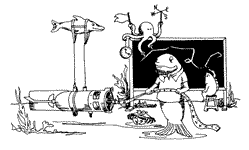
|
The IEEE Seventh Working Conference on Current Measurement TechnologyCurrent and Wave Monitoring and Emerging TechnologiesMarch 13-15 | Bahia Hotel | San Diego, CA, USA |
||
|
Technical Program Accomodations Order the Proceedings Committee and Contact Info |
||
Initial River Test of a Monostatic RiverSonde Streamflow Measurement SystemCalvin C. TeagueStatus: Accepted
Co-Authors: A new RiverSonde streamflow UHF (350 MHz) radar system was tested for
two days during May, 2002 along the San Joaquin River at Vernalis, California.
In contrast to the first bistatic RiverSonde tests, a monostatic geometry
was used for this experiment with the radar antenna placed on one bank
of the river. The RiverSonde is derived from a standard SeaSonde system
normally used at HF to observe currents on the ocean; it was retuned to
a higher frequency consistent with the shorter water wavelengths expected
in the river. A four-element yagi was used for the transmit antenna, with
a broad azimuthal pattern illuminating the water both upriver and downriver
from the radar location. A 3-bay array, consisting of the 4-element transmit
yagi and two 5-element yagis displaced from the central transmitting yagi
by about 0.5 m, was used for the receiver. The yagis were designed using
genetic algorithms to simultaneously optimize the directional response
and feed-point impedance, and their performance was verified by field
calibration using a small transponder. MUSIC direction finding utilizing
both the amplitude and phase responses of all 3 elements was used to locate
the echoes. The monostatic geometry with a wide viewing angle proved almost
ideal, with the downstream motion of the water spreading the echoes widely
in Doppler frequency and almost all energy at a particular frequency bin
coming from a single direction. Consequently, nearly all MUSIC direction
solutions were single-angle, which generally are more robust than dual-angle
solutions. Submitted on October 15, 2002 |
|
Sponsored by the Current Measurement Technology Committee (CMTC) of the IEEE Oceanic Engineering Society. All content reserved. Contact jrizoli@whoi.edu for more information. |
||